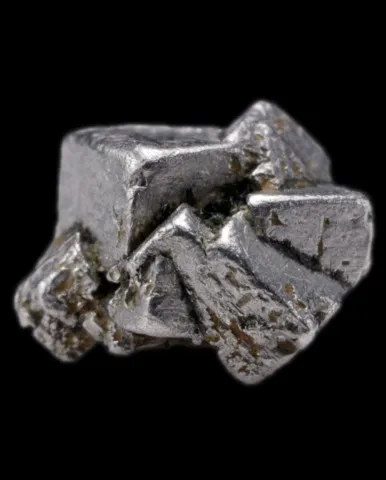PLATINUM
Class : Elements
Subclass : Metals
Crystal system : Cubic
Chemistry : Pt
Rarity : Rare
Native platinum is a primary segregation mineral present in fine inclusions in certain basic (norites) and ultrabasic rocks rich in chromite (dunites), and especially in alluvium resulting from their destruction. The "Merensky Reef" is a platinum horizon of barely metric power but extraordinarily continuous, known over more than 100 km, within the mafic stratified complex of Bushveld : it is the world's largest platinum reservoir. Discovered in 1601 in the river alluvium of Colombia (in Chocos or Caucas depending on the source), platinum nuggets were not identified as a new metal until 1740. The Spanish name platina, which means "little silver", translated the resemblance between these two metals, platinum having the disadvantage of melting much more difficult. Ural platinum was discovered later in 1822, at the time it was used for the manufacture of small value coins (kopecks), hunting pellets and sauerkraut barrel rings ! Some of these “luxury” barrels are kept at the Leningrad Mining Museum (Russia). Native platinum is found in alluvium in the form of flakes or nuggets. It has also been discovered in small cubic crystals, sometimes twinned, exceptionally exceeding 1 cm in edge. With a metallic luster, steel gray color, malleable and ductile, its density is very high (21.5 for refined metal and nearly 19 for natural platinum). It contains iridium (up to 8%), palladium (up to 38%) or rhodium in varying proportions, as well as iron which can make it magnetic (ferroplatinum). It is an important platinum ore and one of the rare metals, along with gold, found in nature mainly in native form. The other important platinum ore is an arsenide : sperrylite. Platinum combines the characteristics which make it an irreplaceable metal in many industrial sectors : very high melting point (1755°C), strong resistance to corrosion, high hardness, powerful catalysis factor, etc... Its main outlet lies currently in automobile catalytic converters but it has many other uses in the chemical and petroleum industries, dentistry and surgical instrumentation, jewelry and electrical equipment. Before becoming this irreplaceable metal, platinum had a successful career among counterfeiters : its high density allowed it to replace gold cheaply without the coins attracting attention because of their excessive lightness ; gold plating was then sufficient to complete the fake coin.
Main photo : Twinned platinum from Konder Massif, Aldan Shield, Khabarovskiy Kray, Russia © Dan Weinrich
Platinum in the World
Twinning
Twins are common on {111}.
Fakes and treatments
No fakes listed for this mineral species.
Hardness : 4 to 4.5
Density : 14 to 19
Fracture : Hackly
Streak : Gray
TP : Opaque
RI : -
Birefringence : 0
Optical character : None
Pleochroism : None
Fluorescence : None
Solubility : Aqua regia
Magnetism : ParamagneticRadioactivity : None


